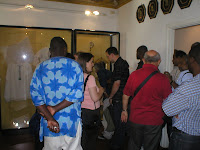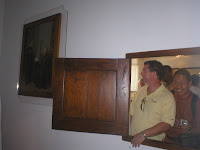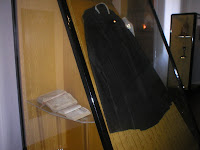Visit to Pagani, South Italy, June 19, 2007
 After breakfast on June 19, the group gathered at the parking lot across the Basilica for the bus that would take them to Pagani.
After breakfast on June 19, the group gathered at the parking lot across the Basilica for the bus that would take them to Pagani.
A big painting of St. Gerard at the front of the Basilica of the Redeemer.

As we arrived in Pagani, just as the bus turned left to take the road down to where the Redemptorist place was, we encountered a funeral procession.
The people just left another church and were walking down this road before breaking up.


Later, we gathered in front of the Basilica of St. Alphonsus in Pagani as our host opened the door which leads to the museum and the convent.

At the lobby of the museum, Felix gives an orientation.

A bronze statue of St. Alphonsus at the lobby.

A bronze statue of St. Gerard also at the lobby.

The inner couryard with a numbeer of lemon trees with lots of fruits.




The church tower dominates over the inner courtyard. During the time of St. Alphonsus, these buildings were used for retreats including ones for the laity.

At a side chapel of the Basilica where the reliquary containing the remains of St. Alphonsus is, the group gathered for Mass. Anton was the celebrant and preacher at this Mass.


The reliquary containing St. Alphonsus' remains. Pope Clement XIII made him a bishop in 1762 (concecrated on June 21, 1762). St. Alphonsus died here at Nocera di Pagani on august 1, 1787. He was 90 years old. He was beatified on September 1816, canonized on May 26, 1839 and declared Doctor of the Church on March 23, 1871.



The painting on the ceiling of the dome of the Basilica showing various saints of the Congregation as well as the Redemptoristines. A figure of St. Francis Assisi is also in the painting.


A stainedglass window with St. Alphonsus' image.


The main painting behind the main altar is that of St. Michael the Archangel.

The image of Mary which was already in the house during the time of St. Alphonsus.

The things he used as bishop are kept in the museum in Pagani.

So are his clothing, including a cloak and a short habit (it is short, to make it easy to ride a horse).

The museum guide, a laywoman, explains to the group the significance of the things exhibited in the museum. At the backdrop are the soutanas used by St. Alphonsus.

Other clothing items and the things he used for self-flagellation.

The room used by St. Alphonsus which has a window opening to the next room. Frank and Jimmy inspect the window.

An old portrait of St. Alphonsus by an anonymous painter.

An intricate scene of Bethlehem during the birth of Christ which goes back to the time of St. Alphonsus. Ives inspect the rare antique.

The organ used by St. Alphonsus for composing his songs.

Another protrait of St. Alphonsus by an anonymous painter.


One of the paintings (left) was painted by St. Alphonsus while the other one was done by a painter who was his friend.

The wheelchair used by St. Alphonsus during the time of his illness.

His death mask.

His shirt when he was already quite sick, the opening is assymetrical as the left part had to be cut off so that it would allow his head to rest on his bosom. To the left of the guide is an old clock.

A fresco painting on the ceiling of the room meant for St. Alphonsus.

Glass cases have original copies of the books he wrote. Dan takes a photo of these.

Original writings with his own handwriting are also exhibited.

The wood shown here made up the original coffin used for the burial of St. Alphonsus.

The scene of downtown Pagani from the second floor of the Basilica which used to be a choir loft but is now used for storage.

The same wood which was the coffin.

A previous funerary statue of St. Alphonsus which is now at the museum.

Other items in the museum.



This is a painting that shows the eruption of Mt. Vesuvius on July 29, 1770. Legend says that St. Alphonsus prayed to ask that the volcano eruption stop. It did which saved the people from what could have been a major catastrophe.

A painting showing St. Alphonsus receving the approved Rule from those who facilitated it. Actually, only two did, Fr. Villani and Bro. Francesco. However, the painting has 4 figures. The Rule was approved by Pope Benedict XIV on February 25, 1749. At that time there were already four communities: Ciorani, Deliceto, Materdomini and Pagani.





0 Comments:
Post a Comment
<< Home